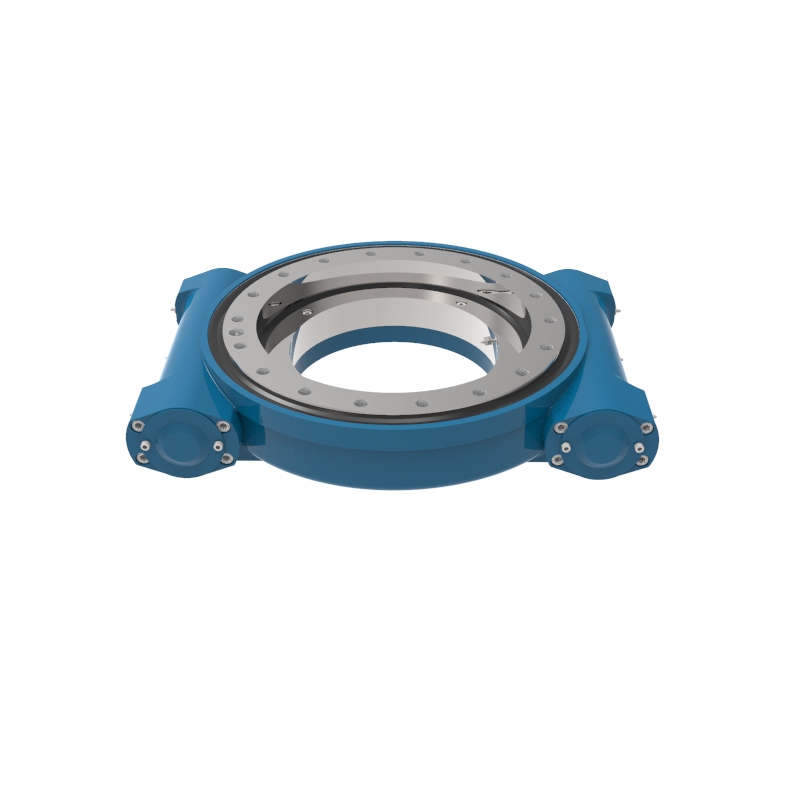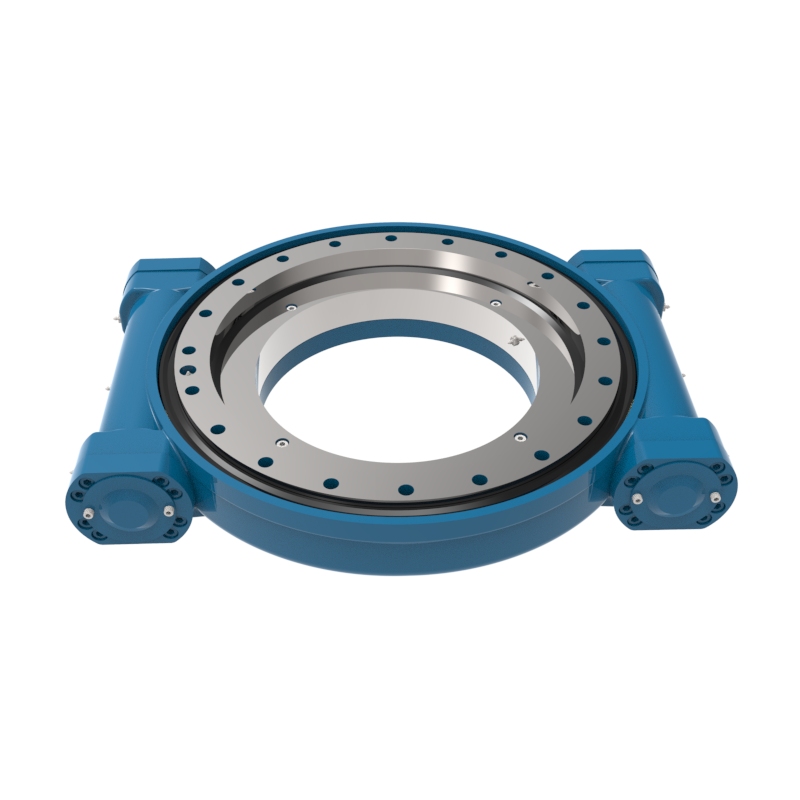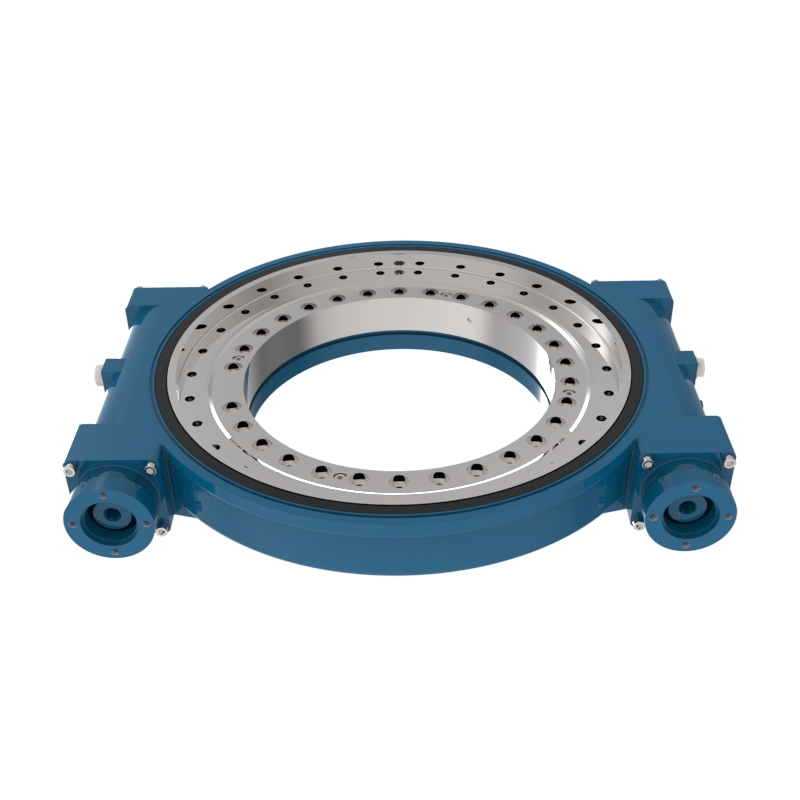A double worm slewing drive includes two worms that engage with the same ring gear. This configuration divides the load between two points of contact, which allows the drive to handle more weight and torque compared to a single worm system. The double worm setup also enhances the overall efficiency and precision of the system.
Double Worm Slewing Drive WED14
The Double Worm Slewing Drive WED14 is a high-performance, self-locking transmission unit that enhances torque, load capacity, and safety for heavy-duty applications, with customization options available to suit specific industry needs.
Read More Get A QuoteDouble Worm Slewing Drive WED17
The Double Worm Slewing Drive WED17 is a high-performance, compact rotational drive system designed for heavy-duty applications, offering high torque, self-locking functionality, and excellent durability in harsh environments, with customizable options to meet specific operational needs.
Read More Get A QuoteDouble Worm Slewing Drive WED21
Output Torque:48kN.mTilting Moment Torque:203kN.mHolding Torque:179.8kN.mGear Ratio:90:1Tracking Precision:≤0.13°
Read More Get A Quote
A slewing drive is a gearbox that can safely hold radial and axial loads, as well as transmit a torque for rotating. The rotation can be in a single axis, or in multiple axes together. Slewing drives are made by manufacturing gearing, bearings, seals, housing, motor and other auxiliary components and assembling them into a finished gearbox. Slewing drives are used in a variety of applications such as cranes, aerial lifts, excavators, wind turbines, solar trackers, and many other applications. Slewing drives come in a variety of configurations, and one of the most effective among these is the double worm slewing drive. This article explores the unique features, advantages, and applications of double worm slewing drives.
What is a Double Worm Slewing Drive?
A double worm slewing drive includes two worms that engage with the same ring gear. This configuration divides the load between two points of contact, which allows the drive to handle more weight and torque compared to a single worm system. The double worm setup also enhances the overall efficiency and precision of the system.
Key Features of Double Worm Slewing Drives
Increased Load Capacity: By distributing the load between two worms, these drives can handle significantly higher axial and radial loads, making them suitable for heavy-duty applications.
Enhanced Accuracy and Precision: Double worm slewing drives offer improved positional accuracy and smoother movement, which is critical in applications requiring precise motion control.
Reduced Backlash: Backlash, or the clearance between the gear teeth, is minimized in double worm configurations. This is crucial for applications where the precision of movement is essential.
Improved Stability and Rigidity: The dual contact points provide better stability and rigidity under load, reducing the risk of deflection and ensuring consistent performance.
Extended Lifespan: The load distribution also reduces the wear and tear on each worm, potentially extending the life of the slewing drive.
Applications of Double Worm Slewing Drives
Double worm slewing drives are particularly useful in applications that require robust performance, high precision, and substantial load-bearing capacity:
Solar Trackers: They are used to precisely position solar panels throughout the day to maximize solar energy absorption.
Wind Turbines: These drives help in adjusting the blades and orientation of wind turbines to optimize wind capture.
Industrial Machinery: Various forms of industrial machinery, including cranes and excavators, benefit from the robustness and precision of double worm slewing drives.
Robotic Arms and Positioners: The precision and load capacity of double worm drives make them ideal for use in robotic arms used in manufacturing and assembly lines.
Satellite Antennas: They are also used in the positioning mechanisms of satellite antennas, where precise and stable movement is paramount.
How to Select a Double Worm Slewing Drive?
Selecting the right double worm slewing drive requires consideration of several factors:
Load Requirements: Assess the maximum radial and axial loads the drive will need to handle.
Environmental Conditions: Consider the environmental conditions in which the drive will operate, such as temperature, humidity, and potential exposure to corrosive elements.
Precision Needs: Determine the required precision and backlash characteristics.
Size and Space Constraints: Evaluate the space available for installing the slewing drive to ensure a proper fit.
Maintenance and Accessibility: Consider how maintenance-friendly the design needs to be based on the application's operational demands.
Double Worm Slew Drive Installation and Operation Manual
Before installing the Double Worm Slew Drive, please read this manual carefully.
This manual provides critical information for proper installation and maintenance procedures.
All installation and maintenance work must be performed by qualified technicians.
For any technical inquiries, please contact our after-sales service department immediately.
1. Transportation, Handling, and Storage
1.1. Transportation and Handling
During transportation, ensure the Double Worm Slew Drive is properly secured in its packaging with correct orientation to prevent impacts or shocks. Always use appropriate lifting equipment with at least three lifting points attached to the designated threaded holes on the housing. Personnel must wear protective gloves during handling operations.
1.2. Storage Requirements
Store the Double Worm Slew Drive in its original packaging in a clean, dry and well-ventilated environment. The factory-applied anti-corrosion protection remains effective for 6 months when kept in sealed packaging. For extended storage periods exceeding 6 months, additional protective measures must be implemented.
2. Installation and Maintenance Procedures
2.1. Pre-Installation Inspection
Thoroughly inspect the Double Worm Slew Drive for any visible damage before installation. Clean all mounting surfaces and adjacent components, removing any contaminants including metal particles, burrs, paint residue or welding slag that may affect installation.
2.2. Surface Preparation
Remove anti-corrosion coatings from mounting surfaces using approved solvents (mineral spirits or equivalent). Avoid solvents that may damage rubber seals or other non-metallic components. Always follow solvent manufacturer's safety guidelines.
2.3. Fastener Selection Guidelines
Note: Our company does not provide installation fasteners. The following are recommendations only:
a. Select fasteners meeting specified size, type and strength requirements
b. Minimum bolt grade requirement: 8.8
c. Required thread engagement: 2 × nominal bolt diameter
d. Prevent fastener protrusion beyond threaded areas
e. For high stress applications, use appropriate high-strength washers
2.4. Recommended Tightening Torques
Refer to the following torque specifications (values in N·m):
| Bolt Size | 8.8 | 10.9 | 12.9 | Bolt Size | 8.8 | 10.9 | 12.9 |
|---|---|---|---|---|---|---|---|
| M5 | 5.6 | 8.2 | 9.6 | M16 | 230 | 338 | 395 |
| M6 | 9.8 | 14.4 | 16.8 | M18 | 320 | 470 | 550 |
| M8 | 24 | 35 | 41 | M20 | 450 | 660 | 772 |
| M10 | 48 | 70 | 82 | M22 | 600 | 880 | 1030 |
| M12 | 83 | 122 | 143 | M24 | 800 | 1175 | 1375 |
| M14 | 130 | 191 | 224 | M27 | 1150 | 1690 | 1975 |
2.5. Installation Procedure
Follow this sequence to ensure proper installation:
a. Apply medium-strength thread locker to all fasteners
b. Tighten bolts in a star pattern in three stages:
First pass: 30% of final torque
Second pass: 60% of final torque
Final pass: 100% of specified torque
c. All bolt holes must be filled. If design constraints prevent this, seal unused holes with silicone to prevent contamination
d. Verify no fastener interference with rotating components
e. Mark fastener positions for future maintenance reference
2.6. Lubrication Specifications
The Double Worm Slew Drive is pre-lubricated with high-performance grease (Shell Gadus S2 V220 or equivalent). Additional lubrication may be required during installation:
a. Worm gear meshing surfaces: Pre-lubricated
b. Bearing assemblies: Pre-lubricated
c. Sealing surfaces: Light coating recommended
2.7. Maintenance and Re-Lubrication Schedule
Service intervals vary based on operating conditions. Conduct regular inspections to determine optimal maintenance frequency. Recommended baseline intervals:
| Operating Environment | Service Interval |
|---|---|
| Light duty (indoor, clean conditions) | 12-18 months |
| Standard industrial applications | 6-12 months |
| Heavy duty (construction, mining) | 3-6 months |
| Extreme conditions (marine, high dust) | 1-3 months |
Note: For continuous operation exceeding 50 hours/week, reduce intervals by 30%. Always inspect lubrication condition during routine maintenance.
3. Safety Considerations
Never operate the drive without proper lubrication
Always disconnect power before performing maintenance
Use only recommended lubricants and replacement parts
Record all maintenance activities in the service log
For technical support or additional documentation, please contact our engineering department






